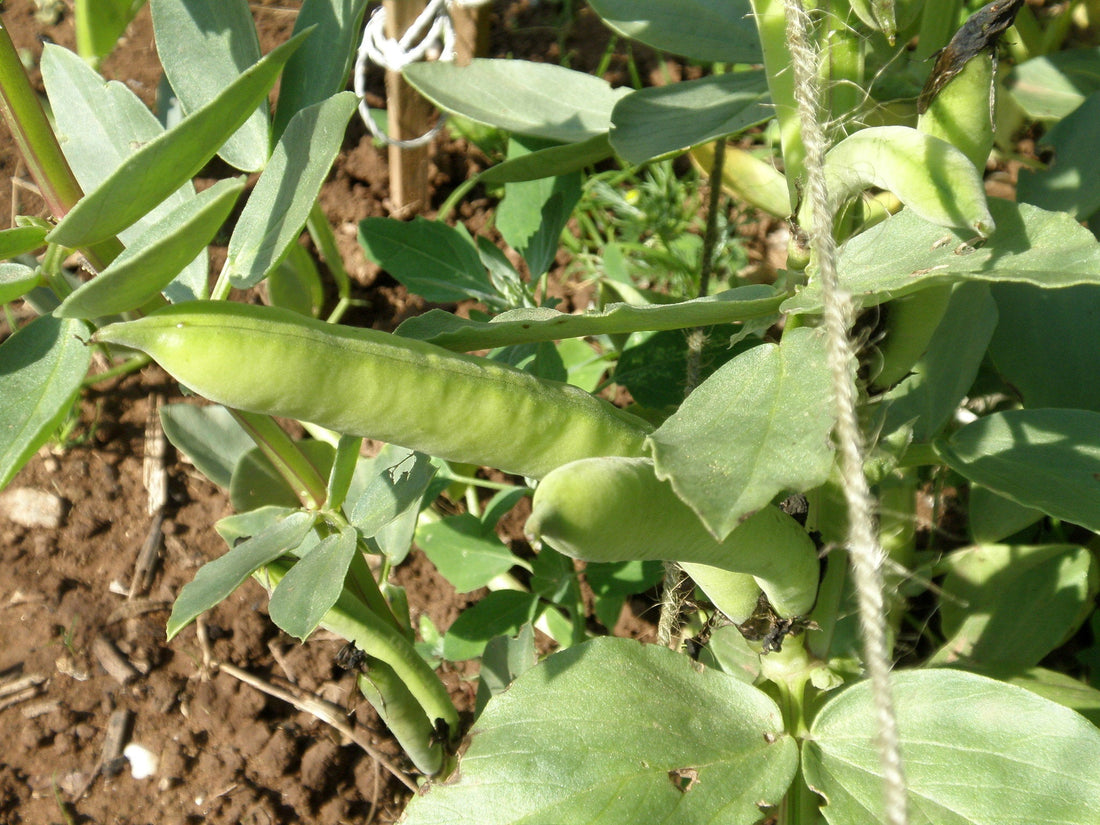
How to Grow Broad Beans from Seed
Broad beans (Vicia faba) are a staple crop in many UK gardens. They’re hardy, easy to grow, and can be one of the first crops to be sown in early spring. Broad beans are valued for their nutty flavour, high nutritional content, and versatility in the kitchen. This guide will cover everything you need to know about growing broad beans successfully in the UK.
Introduction to Growing Broad Beans in the UK
Broad beans are a cool-season crop, making them particularly well-suited to the UK’s climate. They grow best in temperatures between 10-20°C and are one of the few crops that can be sown as early as autumn in mild regions or in early spring. Broad beans are also known for their high protein content, making them a nutritious choice. Growing them at home means you can enjoy fresh beans or dry them for storage, adding both flavour and nutrition to your meals.
Choosing the Right Broad Bean Variety for the UK
Several varieties of broad beans thrive in the UK’s climate, with unique qualities suited to different growing conditions:
- Aquadulce Claudia: A popular, hardy variety suitable for autumn sowing, making it ideal for an early harvest the following spring.
- Masterpiece Green Longpod: Known for its long pods with 6-8 beans per pod, it’s a reliable choice for a high yield in late spring.
- Crimson Flowered: A heritage variety with beautiful crimson flowers, known for its compact size and ornamental appeal, great for smaller gardens.
- Witkiem Manita: A quick-growing variety suited to colder areas and early spring planting, with large beans and good resistance to disease.
Choosing the right variety depends on your preferred sowing time (autumn or spring) and whether you want an early or late harvest. Hardy varieties like Aquadulce Claudia are best for autumn planting, while varieties like Witkiem Manita perform well in early spring.
Preparing the Soil for Broad Beans
Broad beans prefer rich, well-drained soil with plenty of organic matter. Proper soil preparation helps maximise growth and yield.
- Loosening the Soil: Broad beans develop deep roots, so loosen the soil to at least 30 cm. They grow well in various soil types but prefer loam or clay soils enriched with organic matter.
- Adding Organic Matter: Work in well-rotted compost or manure in the autumn before planting to improve soil structure and fertility. This helps retain moisture, which is essential for bean development.
- Soil pH: Broad beans prefer neutral to slightly alkaline soil (pH 6.5-7.5). In more acidic soils, adding garden lime can help raise the pH to the ideal level for beans.
Raised beds can be beneficial if you have poorly drained soil, as broad beans don’t tolerate waterlogging. Avoid using too much nitrogen, as broad beans, like other legumes, fix their own nitrogen in the soil through root nodules.
Planting Broad Bean Seeds
Broad beans can be sown in two main periods in the UK: autumn for an early crop or early spring for a main crop. Here’s how to plant them successfully:
- When to Sow: For an early crop, sow hardy varieties like Aquadulce Claudia in October or November. For a main crop, sow in February to April, depending on regional temperatures and frost risk.
- Sowing Depth and Spacing: Plant seeds 5 cm deep and space them 20-25 cm apart in rows 45 cm apart. This spacing allows airflow and reduces the risk of diseases.
- Direct Sowing: Broad beans prefer to be sown directly in the soil rather than transplanted, as transplanting can disturb their delicate roots.
- Succession Planting: For a continuous harvest, you can sow every few weeks from February to April. This staggered planting helps ensure beans mature at different times.
In areas prone to frost, consider covering autumn-sown seedlings with cloches or fleece to protect them during the coldest months.
Spacing Your Broad Bean Seeds
Proper spacing is essential for broad beans to develop strong, healthy root systems and produce a generous crop of pods. Crowded plants will compete for nutrients, water, and light, potentially reducing your overall yield. On the other hand, leaving ample space around each seed ensures better airflow, helping to prevent diseases and making it easier to tend and harvest your plants.
Guidelines for Spacing:
- Between Seeds: Sow broad bean seeds about 20-25 cm (8-10 inches) apart in each row. This allows each plant room to spread its roots, develop sturdy stems, and maximise pod production.
- Between Rows: Leave 45-60 cm (18-24 inches) between rows to ensure plenty of space for easy access when weeding, watering, and harvesting. Wider spacing also improves air circulation, reducing the risk of fungal diseases.
- Support Structures: If using stakes, canes, or netting to support tall varieties, consider leaving a little extra space between rows. This makes it simpler to work around the supports without damaging young plants or compacting the soil.
Watering and Fertilising
Broad beans are relatively low-maintenance but benefit from regular watering and minimal fertilising.
- Watering Needs: Broad beans require moderate watering, especially during flowering and pod development. Water the base of the plants deeply once a week, more frequently in dry spells. Avoid watering the foliage, as excess moisture on leaves can encourage disease.
- Fertilising Lightly: Broad beans typically don’t require heavy feeding, as they fix nitrogen in the soil. However, an application of a balanced fertiliser or additional compost at planting time provides a boost. If plants appear to be struggling, a light feed of potassium-rich fertiliser can encourage healthy pod formation.
If soil fertility is high from prior composting, additional fertiliser may not be necessary.
Supporting and Managing Broad Bean Growth
Broad beans tend to grow tall and can become top-heavy, especially in windy areas. Here’s how to manage their growth:
- Providing Support: Broad beans can reach heights of 1 meter or more, so they benefit from staking or support to prevent bending or snapping in strong winds. Use garden canes or stakes along each row and tie plants loosely to supports as they grow.
- Pinching Out Tips: When plants start to flower, pinch out the growing tips to encourage energy into pod production. This also helps deter aphids, which are attracted to the young shoots.
- Mulching for Moisture Retention: Applying mulch around the base of the plants can help conserve moisture and prevent weed growth.
Regular maintenance helps ensure strong, upright plants with a high yield. Supporting plants is especially crucial in windy areas to prevent stems from breaking.
Pest and Disease Management
Broad beans are generally hardy but can be susceptible to a few pests and diseases. Here’s how to manage common issues:
- Aphids (Blackfly): Blackfly can infest the tops of broad bean plants. To manage them, pinch out the tips of the plants once flowering begins, or spray aphids with a mild soapy water solution. Introducing ladybirds can also help control aphid populations.
- Chocolate Spot: This fungal disease appears as brown spots on leaves and pods in wet weather. Ensure good airflow by spacing plants properly, avoid overhead watering, and promptly remove affected leaves.
- Slugs and Snails: Young seedlings are particularly vulnerable to slugs and snails. Use copper rings, crushed eggshells, or organic slug pellets to protect plants, especially in damp conditions.
Rotating crops each year can help prevent disease buildup and maintain soil health.
Harvesting and Storing Broad Beans
Timing your harvest correctly ensures broad beans are at their peak flavour and texture.
- When to Harvest: Broad beans are ready to harvest around 12-16 weeks after sowing. Pods should be plump and firm but still tender. For a sweeter taste, pick beans when they’re smaller, around 5-7 cm long. For larger beans, allow them to mature fully in the pods.
- Harvesting Technique: Gently pull each pod from the plant or use scissors to snip them. To avoid damaging plants, support the main stem with one hand while picking.
- Using the Beans: Fresh broad beans can be shelled and eaten raw when young, or boiled or steamed. If the beans have matured, consider double-podding (removing the outer skin) for a sweeter taste.
- Storage: Broad beans can be stored fresh in the refrigerator for up to a week. For longer storage, blanch and freeze them. Alternatively, you can allow beans to mature and dry on the plant, then store dried beans in an airtight container.
If you let the beans dry, they can be used in stews and soups or saved for planting next year.
Common Problems and Solutions
Despite being hardy, broad beans may encounter some issues:
- Poor Pod Development: Lack of pods can be due to poor pollination, particularly in wet weather. Planting companion flowers nearby can attract pollinators and improve yields.
- Wilting Plants: This can indicate root rot due to waterlogged soil. Ensure soil is well-drained and avoid over-watering.
- Spindly Growth: Often caused by low light or overcrowding. Space plants properly and choose a sunny location.
Crop rotation, good soil management, and timely interventions can help prevent these issues.
Frequently Asked Questions
Q: Can broad beans be grown in containers?
A: Yes, broad beans grow well in deep containers. Use a pot at least 30 cm deep and provide support for taller varieties. Ensure good drainage and keep the soil consistently moist.
Q: Should I remove the growing tips of broad beans?
A: Yes, pinching out the tips once plants start flowering encourages pod development and helps deter aphids.
Q: How long do broad beans take to mature?
A: Broad beans typically mature in 12-16 weeks. For autumn-sown plants, you can expect a harvest in early spring; for spring-sown plants, harvest is usually in early summer.
Summary and Additional Resources
Growing broad beans in the UK can be easy and rewarding with the right approach. Here’s a quick recap:
- Choose hardy varieties for autumn sowing and traditional varieties for spring planting.
- Prepare nutrient-rich, well-drained soil and space plants for good airflow.
- Support plants as they grow tall and pinch out tips to boost yields.
- Harvest when pods are firm, and store fresh or freeze for later use.
For more detailed advice, the Royal Horticultural Society (RHS) offers valuable resources, and "Grow Your Own Vegetables" by Joy Larkcom is a trusted guide tailored to UK gardeners.
With these tips, you’re well-equipped to enjoy a successful harvest of broad beans, providing a delicious, nutritious addition to your garden and kitchen.
